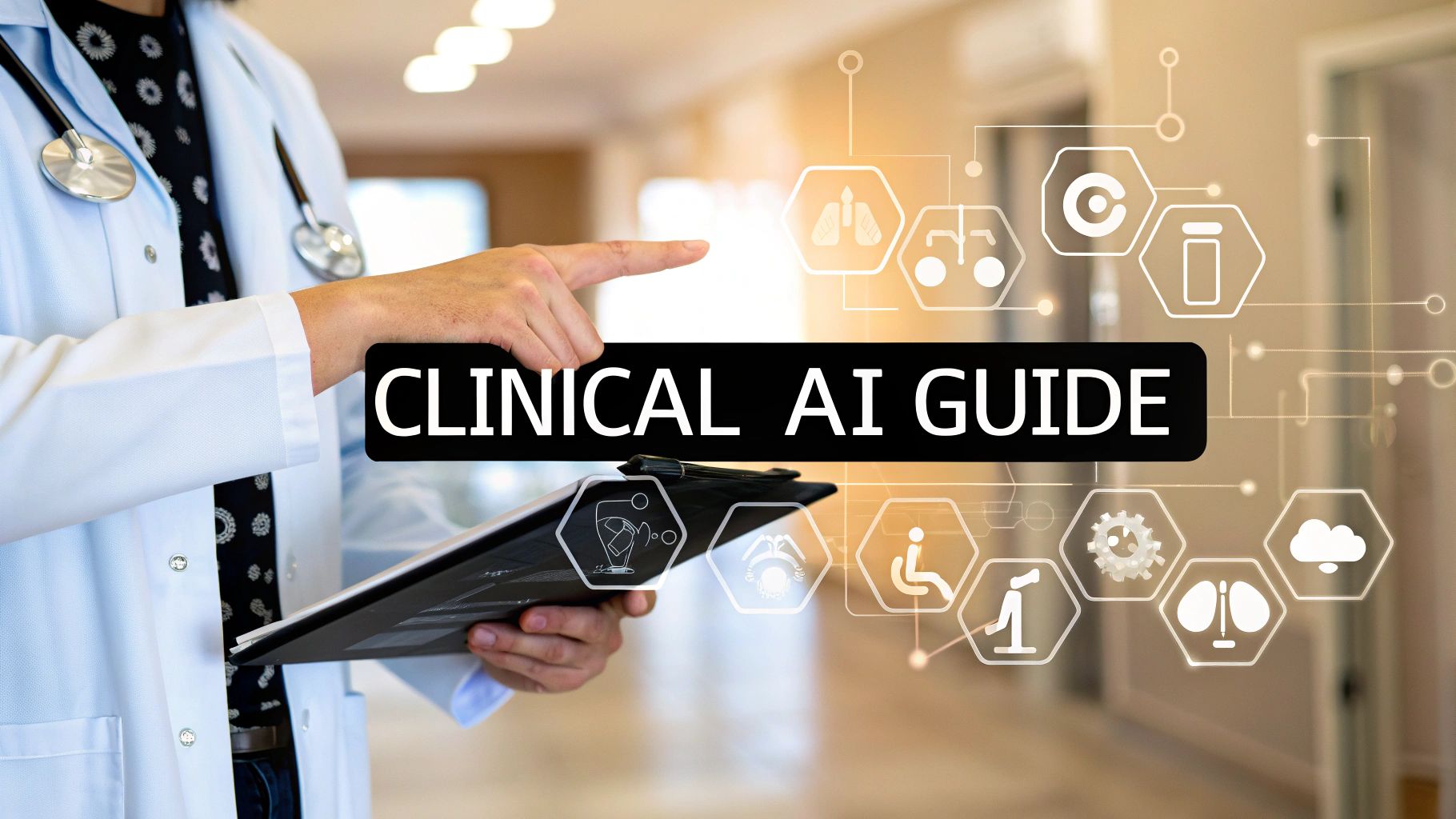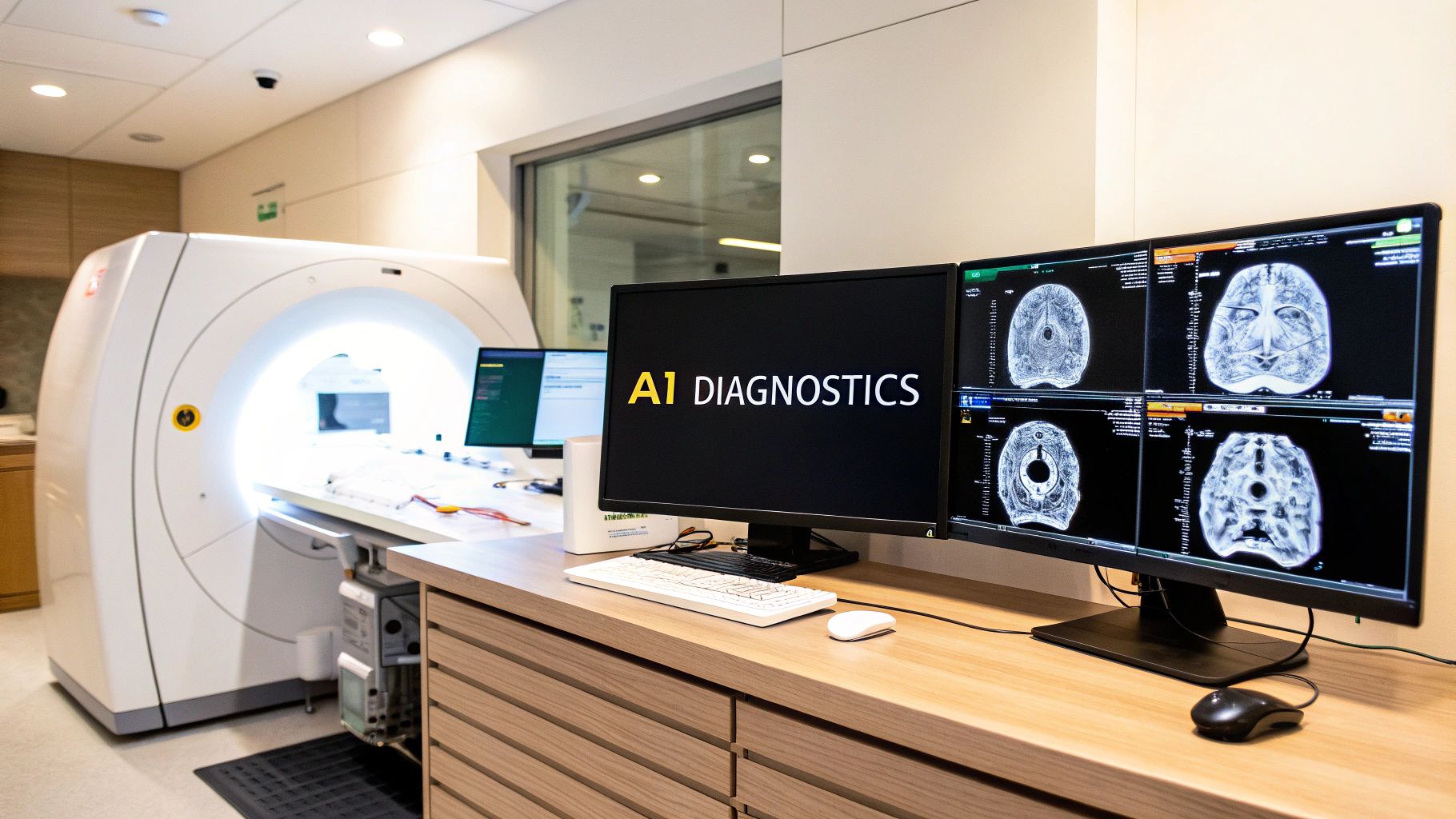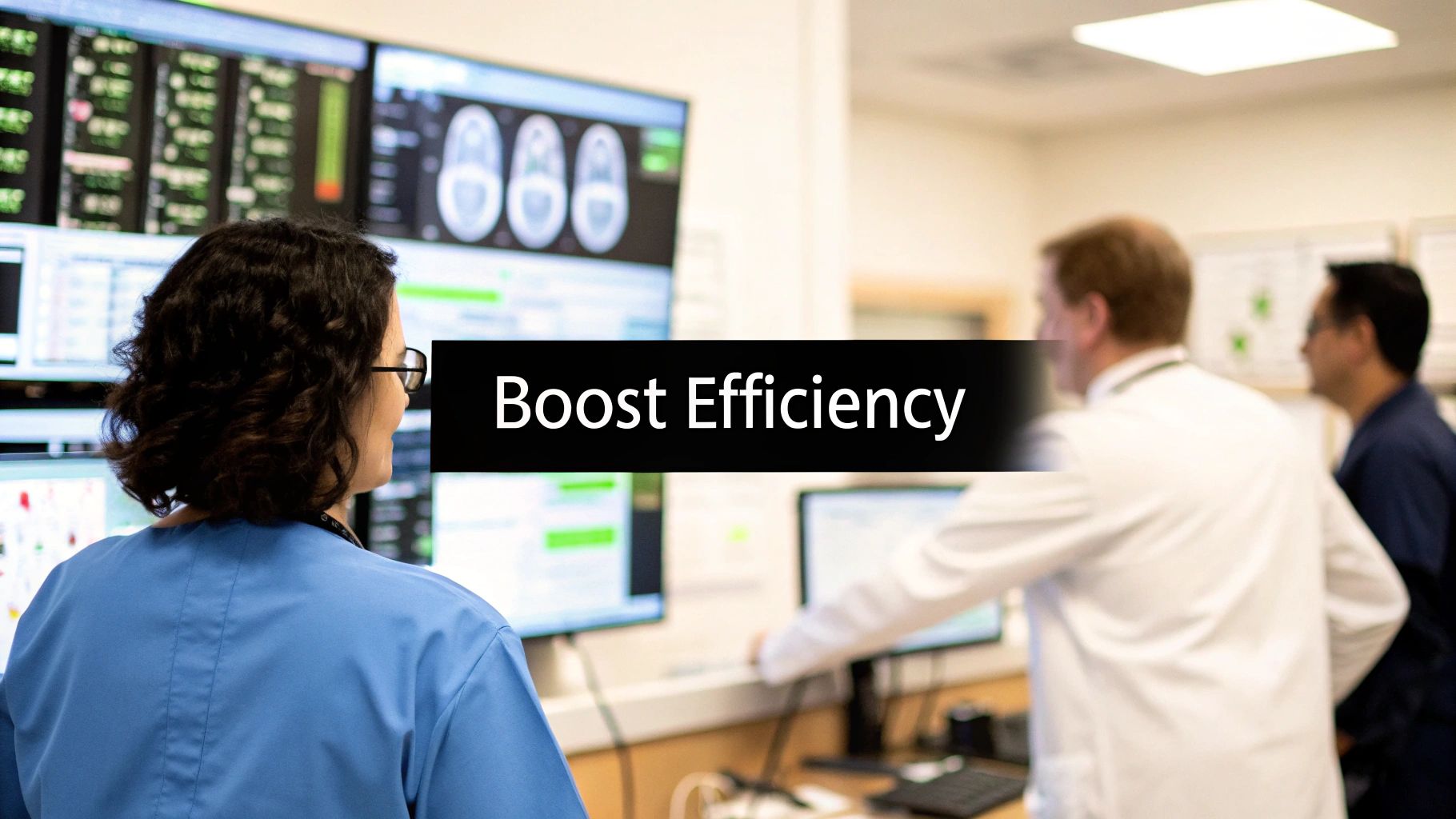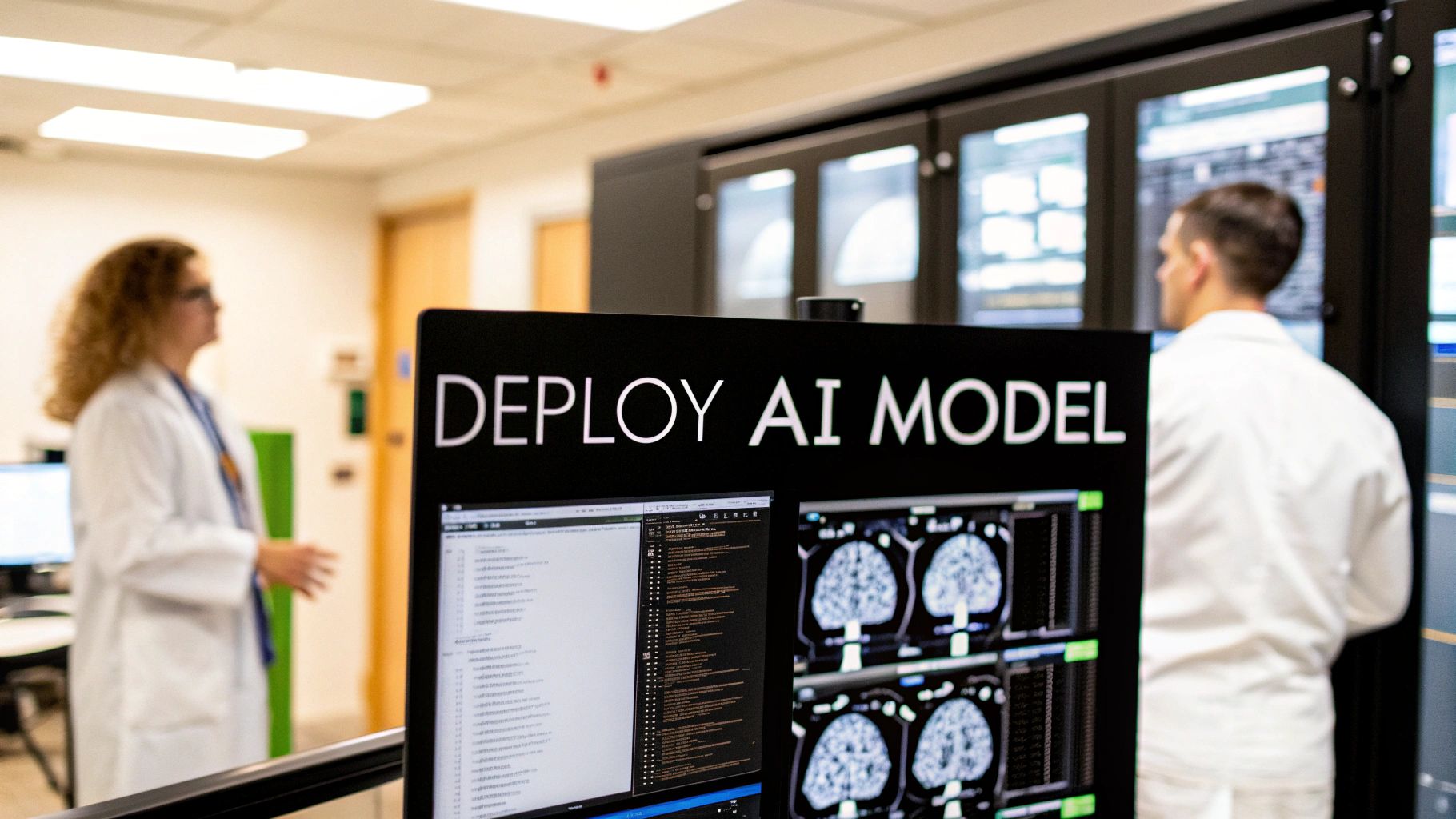The Revolution Unfolding in Radiology Departments
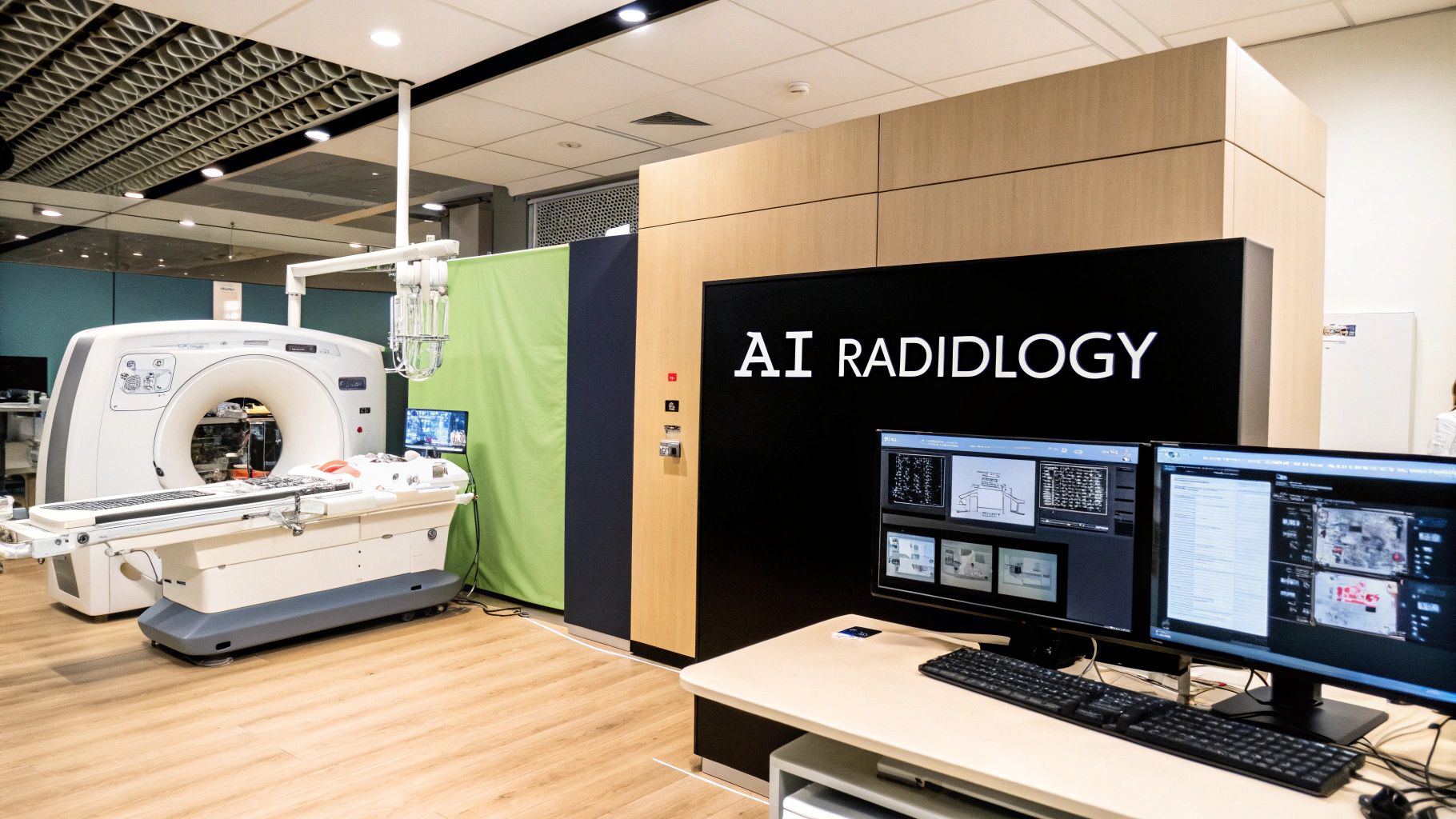
Artificial intelligence (AI) is rapidly transforming the field of radiology. It's no longer a futuristic concept but a practical tool actively reshaping how radiologists work. This transformation is evident in the shift from traditional image analysis to AI-enhanced workflows now being implemented in hospitals globally. But what exactly does this mean for the day-to-day operations of a radiology department?
One of the most significant impacts of AI is its ability to address the growing challenges of increasing imaging volumes and staffing shortages. Radiology departments are under immense pressure to interpret more images with fewer resources. AI algorithms can help by automating time-consuming tasks like image pre-processing and measurements. This frees up radiologists to focus on more complex cases and, importantly, allows for more direct patient interaction.
This increased efficiency translates to faster turnaround times for reports, a crucial factor in improving patient care. Faster diagnoses mean patients can begin treatment sooner, leading to better outcomes. AI algorithms are also proving invaluable in enhancing diagnostic accuracy.
AI-powered tools can be trained to detect subtle abnormalities that might be missed by the human eye. This increased sensitivity is particularly important in areas like cancer detection, where early intervention is critical. In such cases, AI isn't just a tool for efficiency; it's a powerful aid in improving patient outcomes and potentially saving lives.
Moreover, the integration of AI in radiology is accelerating. Recent years have seen a sharp rise in AI applications, particularly focusing on diagnostic accuracy and workflow efficiency. By 2025, the use of generative AI is projected to expand, using foundational models to assist with patient summarizations and integration with electronic medical records. Approximately 75% of the over 500 FDA-cleared AI algorithms are focused on radiology, highlighting the rapid growth and importance of AI in this field. This integration is essential given the continuous increase in imaging studies and the need for timely and accurate diagnoses. Radiology Business offers further insights into these evolving trends.
Impact of AI on Radiologist Workflows
AI is fundamentally changing how radiologists work, augmenting their capabilities rather than replacing them. Think of AI as a highly skilled assistant capable of handling routine tasks. This allows radiologists to dedicate their expertise to complex diagnoses and patient management, where their skills are most needed. Some key benefits include:
- Improved Efficiency: AI automates repetitive tasks, which reduces report turnaround times.
- Enhanced Accuracy: AI algorithms can detect subtle abnormalities often missed, improving diagnostic confidence.
- Standardized Reporting: AI contributes to more standardized and consistent reporting across departments.
- Reduced Burnout: By lessening workload pressure, AI can help reduce radiologist burnout.
This shift toward AI-enhanced workflows represents a significant advance in radiology, leading to improved patient care and more efficient departments. The ongoing integration of AI and human expertise promises a future of better diagnostic outcomes.
Breaking Boundaries in Diagnostic Imaging
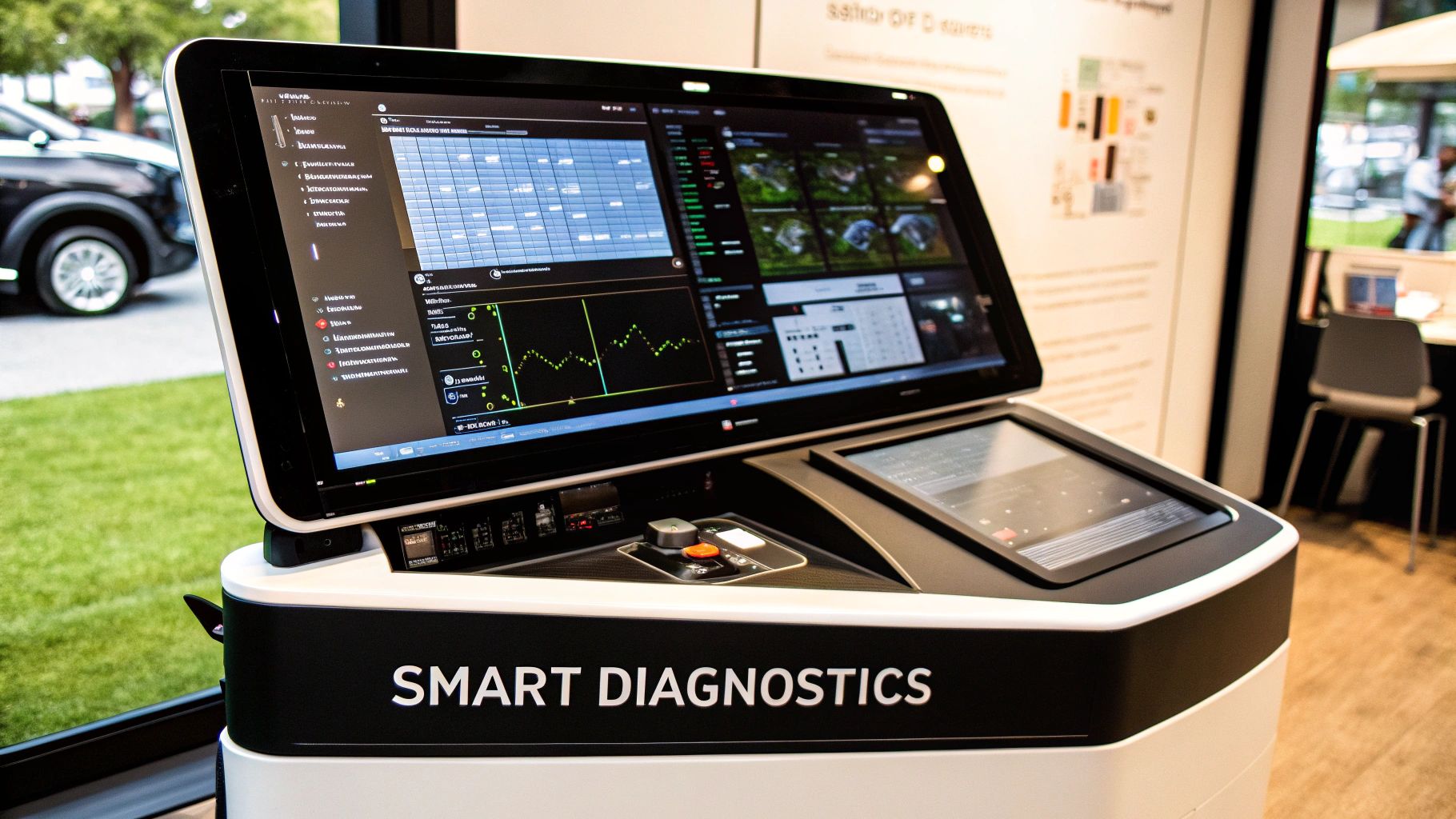
Artificial intelligence is rapidly changing the field of diagnostic imaging. It's not simply automating tasks; it's enabling radiologists to gain deeper insights and make more precise diagnoses. This progress is evident across a wide range of imaging modalities, from identifying tiny lung nodules on chest X-rays to conducting complex tumor analysis in MRI studies.
AI-Powered Detection and Diagnosis
One of the most significant advancements in AI radiology is the detection of subtle abnormalities. AI algorithms can be trained to spot small lung nodules on chest X-rays, which can often be difficult for the human eye to detect. This early detection capability is vital for timely intervention and treatment of lung cancer.
AI is also playing a crucial role in analyzing complex MRI scans. It assists radiologists in accurately identifying and characterizing tumors, which is essential for planning treatment strategies and monitoring disease progression.
Furthermore, AI is broadening the range of conditions radiologists can diagnose. By analyzing images from multiple modalities, such as CT and ultrasound, AI can identify fractures, assess organ damage, and even detect early indicators of neurological disorders. This enhanced accuracy and efficiency allows radiologists to dedicate more time to complex cases and patient communication.
Streamlining Radiology Workflows with AI
Beyond improving diagnostic capabilities, AI is also streamlining radiology workflows. It's reducing image interpretation time and improving the quality of reports across practices. Some AI tools automate the measurement of lesions and the generation of reports, freeing up radiologists' time.
This automation allows radiologists to focus on image interpretation and personalized patient care. AI can also standardize reporting, ensuring consistency and minimizing variability among different radiologists and institutions. Standardized reports facilitate clearer communication among healthcare providers, further enhancing patient care.
To illustrate the diverse applications of AI in radiology, the following table summarizes key use cases and benefits across different imaging modalities.
To help illustrate the applications of AI across various imaging methods, we’ve put together a table summarizing key use cases and benefits:
| Imaging Modality | Key AI Applications | Clinical Benefits | Implementation Challenges |
|---|---|---|---|
| X-ray | Lung nodule detection, bone fracture identification | Improved diagnostic accuracy, faster turnaround times | Data quality variability, integration with existing systems |
| CT | Organ segmentation, lesion characterization | Enhanced visualization, precise measurements | Computational resources, algorithm training |
| MRI | Tumor analysis, brain imaging analysis | Detailed anatomical information, early disease detection | Cost of implementation, data privacy |
As shown in the table above, each modality presents its own set of opportunities and challenges for AI integration. Addressing these challenges will be crucial for maximizing the potential of AI in radiology.
Real-World Applications of AI in Radiology
Leading institutions are already implementing AI tools in their diagnostic workflows, and the results are promising. Some hospitals are using AI-powered software to triage imaging studies, prioritizing urgent cases and ensuring prompt diagnoses for critical patients. This increased efficiency benefits patients and reduces the strain on radiology departments. AI’s ability to analyze complex images, detect subtle patterns, and automate tasks is driving faster, more accurate diagnoses, ultimately leading to better patient care and outcomes.
The Real Economic Impact of AI-Enhanced Workflows
The integration of artificial intelligence (AI) into radiology workflows is transforming the field's economics. It's not simply about better diagnoses; it's about creating a more sustainable and efficient healthcare system. Forward-thinking practices are already seeing tangible economic benefits by using AI to tackle persistent challenges.
Increased Productivity and Reduced Burnout
A primary economic advantage of AI is increased productivity. AI can manage time-consuming tasks, such as image pre-processing and measurements. This frees up radiologists to focus on more complex diagnoses, increasing the overall throughput of a radiology department.
For example, AI can efficiently clear patient backlogs, reducing the need for callbacks and improving report turnaround times. This improved efficiency translates to a greater number of patients seen and diagnosed, ultimately increasing revenue potential.
Furthermore, by lessening workload pressure, AI can contribute to reduced radiologist burnout. This leads to higher job satisfaction and better staff retention, minimizing recruitment and training costs.
The adoption of AI in radiology continues to grow, benefiting both diagnostic accuracy and productivity. Currently, about one-third of organizations utilize AI in medical imaging, with imaging centers leading at 34.7% utilization. Computer-aided detection (CAD) of diseases makes up nearly 93% of AI applications in radiology.
AI assists in productivity by clearing patient backlogs and decreasing callbacks, improving turnaround times for scan assessments. The financial benefits are significant. Estimations suggest AI in healthcare could generate $150 billion in annual savings for the U.S. healthcare economy by 2026. This trend of AI-driven productivity and cost reduction is expected to continue as AI becomes further integrated into radiology workflows. Find more detailed statistics here.
Improved Patient Outcomes and Reduced Costs
The economic impact of AI extends beyond the radiology department. Earlier disease detection, made possible by AI, can prevent the need for costly late-stage treatments. Faster diagnosis and prompt treatment initiation can also reduce hospital stays, further lowering healthcare expenses. This creates a more efficient and cost-effective healthcare system overall.
Consider a patient with potential lung cancer. AI-powered tools can assist radiologists in identifying subtle nodules on chest X-rays that might otherwise be missed. This early detection can lead to less invasive and less expensive treatments, significantly impacting long-term patient care costs.
Real-World Metrics and Return on Investment
The economic benefits of AI in radiology are demonstrable. Real-world metrics show significant improvements in turnaround times, report quality, and patient outcomes. These measurable improvements contribute to a strong return on investment for healthcare providers.
Some practices have reported a dramatic decrease in report turnaround time after implementing AI—from several days to just a few hours. This increased efficiency allows for faster patient diagnosis and treatment, positively impacting patient satisfaction and healthcare quality. This efficiency directly translates to increased profitability for healthcare institutions by enabling them to see more patients while reducing operational costs.
By automating routine tasks, AI helps reduce labor costs and minimizes the need for additional staff, freeing up resources for other important areas of patient care. The future of AI in radiology is promising. As AI continues to evolve, we can anticipate even greater economic benefits, from increased productivity and reduced costs to improved patient outcomes. This makes AI integration in radiology not just a technological advancement, but a sound economic strategy.
Cutting-Edge Research Transforming Radiological Practice
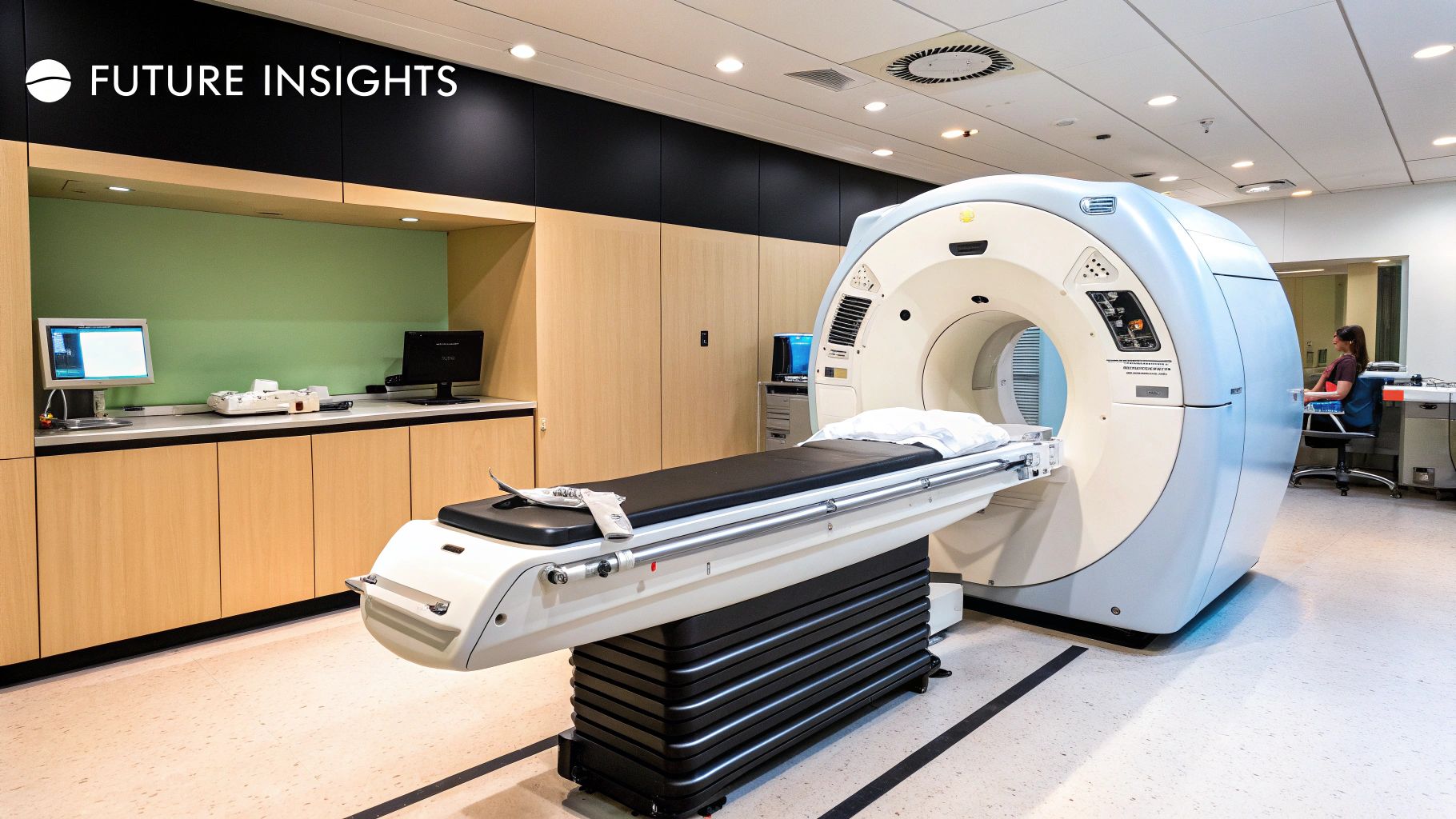
The field of artificial intelligence (AI) in radiology is constantly evolving. Identifying impactful research and innovations is crucial for clinical practice. This involves focusing on developments with tangible improvements in patient care and diagnostic accuracy, rather than just hype. Deep learning architectures, for instance, are demonstrating considerable potential for analyzing medical images. Furthermore, research is increasingly using AI tools like an AI email assistant to enhance productivity.
Deep Learning Architectures for Enhanced Image Analysis
Deep learning stands at the forefront of AI research in radiology. Various deep learning architectures are proving effective for specific imaging needs. For example, Convolutional Neural Networks (CNNs) excel at image recognition. They are used to detect subtle anomalies like small lung nodules and classify tumors. Recurrent Neural Networks (RNNs), however, are suited to sequential data analysis, like time-series images used in cardiac imaging. This specialization improves accuracy and efficiency in medical image analysis.
Multimodal AI for Unprecedented Insights
Researchers are combining imaging data with clinical information through multimodal AI models. These models integrate data from various sources like patient history, lab results, and genetic information with imaging data. This gives a more complete, personalized view of a patient's condition. A multimodal AI model might combine a patient’s mammogram with family history to improve breast cancer risk assessment. This integrated approach enables a more nuanced and personalized diagnosis and treatment plan.
Key Research Areas and Emerging Technologies
Several key research areas drive innovation in AI radiology. Federated learning enables AI model training across institutions without sharing sensitive data. This speeds up development of robust, generalizable algorithms. Explainable AI (XAI) aims to make the decision-making processes of AI algorithms transparent and understandable to clinicians. This builds trust and ensures responsible implementation. Bibliometric analysis highlights the growth in AI research in radiology, nuclear medicine, and medical imaging (RNMMI). By 2021, RNMMI publications reached 11,209, with AI and machine learning publications growing annually at 29.8%. Deep learning publications show the most substantial growth. Learn more here.
Collaborative Networks and Institutions Driving Innovation
Collaboration is key to advancing AI in radiology. Research institutions, hospitals, and tech companies are creating networks to share data, expertise, and resources. This speeds up the development and validation of AI algorithms. Organizations like the Radiological Society of North America (RSNA) promote AI research and education. These collaborations are moving the field towards integrating AI into radiological practice, improving patient outcomes, and transforming healthcare. This collaborative effort ensures the development of safe, effective, and ethical AI solutions for radiology.
Navigating the Human Side of Technological Change

Artificial intelligence is transforming radiology. However, technology's impact goes beyond algorithms and hardware. It significantly affects both patients and providers. Understanding this human dimension is crucial for successful AI integration in healthcare. This involves patient perspectives, ethical concerns, and the evolving roles of radiologists.
Patient Perspectives and Acceptance of AI
Patients may initially feel apprehensive about AI's role in their diagnosis. This is natural, as many prefer a physician's personal touch. However, as patients learn about AI's benefits – like improved accuracy and speed – their comfort levels tend to increase. These benefits can lead to earlier diagnosis and treatment, reassuring patients that AI is a valuable tool.
Imagine a patient anxious about a potential cancer diagnosis. AI-powered image analysis can significantly reduce this anxiety by providing quick, reliable results. This speed can greatly impact a patient's emotional well-being. Furthermore, explaining how AI assists, rather than replaces, their doctor builds trust and acceptance.
Public discussions about AI in medical imaging, especially on social media, reveal mixed feelings. Analysis shows mostly positive sentiments about AI enhancing diagnostic accuracy and efficiency, thereby reducing radiologists' workloads. For example, automating tasks like image sorting lets radiologists focus on complex analyses. However, ethical and privacy concerns remain, highlighting the need for responsible AI integration. Explore this topic further here. This necessitates ongoing dialogue among developers, providers, and the public.
Ethical Considerations and Algorithm Bias
Addressing ethical considerations is paramount as AI becomes more prevalent. Algorithm bias is a key concern. If AI models train on unrepresentative data, they may produce inaccurate or biased results for certain groups. This raises questions about fairness and equity in healthcare. Who is responsible if an AI-driven diagnosis is incorrect? The radiologist? The software developer? The hospital? Clear guidelines and protocols are needed.
Ensuring diverse patient populations benefit equally from AI is critical. This requires developing and training AI models on diverse datasets representing different ethnicities, genders, and socioeconomic backgrounds. This inclusive approach minimizes bias and ensures equitable access to high-quality care.
The Evolving Role of the Radiologist
AI is not replacing radiologists; it's changing their role. By taking over routine tasks, AI frees radiologists to focus on complex cases requiring human expertise and critical thinking. This shift allows more time for patient interaction, personalized explanations, and emotional support.
This transition creates new specialization opportunities in AI integration and interpretation. Radiologists will increasingly act as expert overseers of AI-powered systems, validating findings and making final decisions. This emphasizes the continuing importance of the human element in radiology and the need for ongoing professional development. This integration of AI and human expertise will define the future of radiology, leading to better patient outcomes and a more humane approach to care.
What's Next: The Future of Artificial Intelligence Radiology
Artificial intelligence (AI) is already impacting radiology significantly. The field continues to evolve, with innovations promising to reshape radiological practice further. This constant evolution requires institutions and professionals to adapt to the changing dynamics of AI in radiology.
From Image Analysis to Clinical Support
Currently, AI in radiology focuses primarily on image analysis—detecting anomalies, assisting with measurements, and similar tasks. The future of AI, however, extends beyond this. Generative AI, for example, is becoming a potent tool for comprehensive clinical support. This next-generation AI can create preliminary reports, integrate with electronic health records (EHRs), and offer decision support based on extensive medical knowledge. This shift allows for faster diagnoses and more personalized treatment plans.
Imagine an AI system that not only identifies a potential tumor in a CT scan but also automatically generates a preliminary report summarizing the findings. This system could also pull relevant patient history from their EHR and suggest potential next steps based on current medical guidelines. This level of integration transforms the radiologist's workflow, freeing up more time for complex cases and direct patient interaction.
Personalized Scan Protocols and Automated Follow-Up
Leading institutions are preparing for an AI-driven future that spans the entire imaging process. This includes developing personalized scan protocols based on individual patient characteristics and automating follow-up recommendations. Instead of a one-size-fits-all approach, AI can tailor scanning parameters to optimize image quality and minimize radiation exposure for each patient.
AI can also automate routine follow-up scheduling and reminders, ensuring patients receive timely care and reducing administrative burdens. This personalized and automated approach streamlines the entire radiology process, ultimately leading to improved patient outcomes.
To better understand the evolution of AI's role in radiology, take a look at the following table:
This table presents the progression of artificial intelligence functionality in radiology, from basic image analysis to advanced clinical integration.
| AI Generation | Key Capabilities | Clinical Integration Level | Example Applications |
|---|---|---|---|
| First Generation | Image analysis, automated measurements | Basic assistance | Lung nodule detection, bone age assessment |
| Second Generation | Preliminary report generation, EHR integration | Intermediate assistance | Automated summarization of findings, risk stratification |
| Third Generation | Personalized scan protocols, automated follow-up | Advanced integration | Tailored imaging parameters, predictive modeling |
As shown in the table, the capabilities of AI in radiology have grown significantly, promising even greater advancements in patient care.
The Regulatory Landscape and a Roadmap for the Future
The rapid advancement of AI in radiology requires careful consideration of the regulatory landscape. Agencies like the FDA play a vital role in ensuring the safety and efficacy of AI-powered medical devices. Navigating these regulations is essential for both developers and healthcare providers.
To thrive in this evolving environment, radiology practices need a clear roadmap. This roadmap should focus on several key areas:
- Investing in AI Training and Education: Equipping radiologists with the skills to use and interpret AI-generated results effectively.
- Developing Clear Ethical Guidelines: Establishing clear guidelines for the ethical use of AI in diagnosis and treatment decisions.
- Building Strong Partnerships with Technology Providers: Collaboration between healthcare providers and AI developers is crucial for successful implementation.
- Focusing on Data Security and Privacy: Protecting patient data is paramount as AI becomes more integrated into healthcare systems.
By focusing on these key aspects, radiology practices can prepare for the future of AI and harness its potential to improve patient care.
Take Your Radiology Practice to the Next Level with PYCAD
PYCAD specializes in integrating artificial intelligence into medical imaging. With extensive experience in AI development and deployment, PYCAD offers comprehensive solutions to optimize medical devices, enhance diagnostic accuracy, and improve operational efficiency. From data handling and model training to creating custom APIs and MVP UIs, PYCAD provides robust support tailored to your specific needs. Visit PYCAD today to learn how they can help you navigate the future of AI in radiology and transform your practice.


